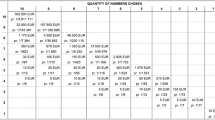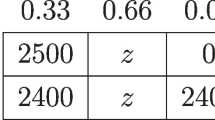Abstract
We report the results of an experiment which investigates the impact of the manner in which likelihood information is presented to decision-makers on valuations assigned to lotteries. We find that subjects who observe representative sequences of outcomes attach higher valuations to lotteries than those who are given only a verbal description of a probability distribution. We interpret this in terms of a reduction in ambiguity about the possible lottery outcomes. These findings suggest that ambiguity aversion may be a confounding factor in reported experimental violations of expected utility theory based on verbal descriptions of probability distributions.
Similar content being viewed by others
References
G. Becker M. DeGroot J. Marschak (1964) ArticleTitleMeasuring utility by a single-response sequential method Behavioral Science 9 226–232
C. Camerer (1995) Individual decision making J.H. Kagel A.E. Roth (Eds) The Handbook of Experimental Economics Princeton University Press Princeton
C. Camerer M. Weber (1992) ArticleTitleRecent developments in modelling preferences: Uncertainty and ambiguity Journal of Risk and Uncertainty 5 325–370 Occurrence Handle10.1007/BF00122575
R. Cubitt C. Starmer R. Sugden (1998) ArticleTitleOn the validity of the random lottery incentive system Experimental Economics 1 115–131
R. Cubitt A. Munro C. Starmer (2004) ArticleTitleTesting explanations of preference reversal Economic Journal 114 707–726 Occurrence Handle10.1111/j.1468-0297.2004.00238.x
H.J. Einhorn R.M. Hogarth (1986) ArticleTitleDecision making under ambiguity Journal of Business 59 225–249 Occurrence Handle10.1086/296364
D. Ellsberg (1961) ArticleTitleRisk, ambiguity and the Savage axioms Quarterly Journal of Economics 75 643–696 Occurrence Handle10.2307/1884324
W.K. Estes (1976a) ArticleTitleThe cognitive side of probability learning Psychological Review 83 37–64 Occurrence Handle10.1037//0033-295X.83.1.37
W.K. Estes (1976) Some functions of memory in probability learning and choice behavior G.H. Bower (Eds) The Psychology of Learning and Motivation NumberInSeriesvol. 10 Academic Press New York
C. Fox A. Tversky (1995) ArticleTitleAmbiguity aversion and comparative ignorance Quarterly Journal of Economics 110 585–603 Occurrence Handle10.2307/2946693
G. Gigerenzer U. Hoffrage (1995) ArticleTitleHow to improve Bayesian reasoning without instruction: Frequency formats Psychological Review 102 684–704 Occurrence Handle10.1037/0033-295X.102.4.684
C. Harries N. Harvey (2000) ArticleTitleAre absolute frequencies, relative frequencies, or both effective in reducing cognitive biases? Journal of Behavioral Decision Making 13 431–444 Occurrence Handle10.1002/1099-0771(200010/12)13:4<431::AID-BDM363>3.0.CO;2-1
C. Heath A. Tversky (1991) ArticleTitlePreference and belief: Ambiguity and competence in choice under Uncertainty Journal of Risk and Uncertainty 4 5–28 Occurrence Handle10.1007/BF00057884
C. Holt (1986) ArticleTitlePreference reversals and the independence axiom American Economic Review 76 508–515
S.J. Humphrey (1999) ArticleTitleProbability learning event-splitting effects and the economic theory of choice Theory and Decision 46 51–78 Occurrence Handle10.1023/A:1004984621705
E. Karni Z. Safra (1987) ArticleTitlePreference reversal and the observability of preferences by experimental methods Econometrica 55 675–685
J. Kisielius B. Sternthal (1986) ArticleTitleExamining the vividness controversy: An availability valence interpretation Journal of Consumer Research 12 418–431 Occurrence Handle10.1086/208527
B.W. Pelham T.T. Sumarta L. Myaskovsky (1994) ArticleTitleThe easy path from many to much: The numerosity heuristic Cognitive Psychology 26 103–133 Occurrence Handle10.1006/cogp.1994.1004
U. Segal (1988) ArticleTitleDoes the preference reversal phenomenon necessarily contradict the independence axiom? American Economic Review 78 233–236
C. Starmer R. Sugden (1991) ArticleTitleDoes the random-lottery incentive system elicit true preferences? An experimental investigation American Economic Review 81 971–978
A. Tversky P. Slovic D. Kahneman (1990) ArticleTitleThe causes of preference reversal American Economic Review 80 204–217
Author information
Authors and Affiliations
Corresponding author
Rights and permissions
About this article
Cite this article
Bleaney, M., Humphrey, S.J. An Experimental Test of Generalized Ambiguity Aversion using Lottery Pricing Tasks. Theor Decis 60, 257–282 (2006). https://doi.org/10.1007/s11238-005-4573-1
Issue Date:
DOI: https://doi.org/10.1007/s11238-005-4573-1




